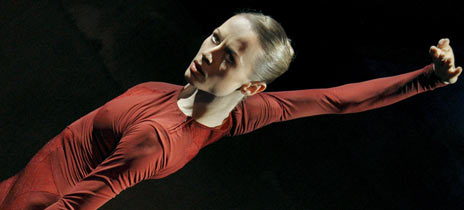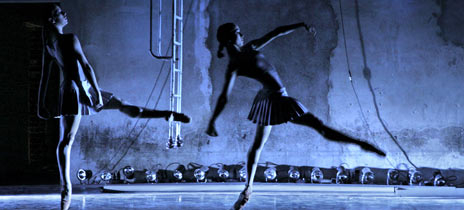- ‘Shut Up and Dance!’ was a well intentioned, Berghain/Staatsballett Berlin interspecies breeding program. High profile producers including Tobias Freund, Sleeparchive and Luciano contributed specially composed tracks to the project, to be used as ballet backdrop. Electronic music composed for ballet is not a new idea, its history stretches back almost to the beginnings of electronic music: Pierre Henry composed several works for the ballet in the 1960s, and more recently, Christian Vogel composed scores and live soundtracks that have been performed by several large ballet companies. Bringing electronic music to the ballet is not difficult, shocking or unheard-of, what was unusual about this project was the effort to bring the ballet to clubland.
The musical progeny of the union, ‘Shut Up and Dance! updated’ (Ostgut Ton), was a healthy five-tracker that worked surprisingly well as a compilation, each track also able to stand on its own merits: the burbling, hey-day-of-synthesizer ‘Fiori’ from Ame and Luciano’s comic ‘Drunken Ballet’ were standouts, the latter to be released on vinyl with a remix from Moritz von Oswald.
 But the performance itself was a sickly hybrid - and not just because of the (p)reviews. It is “a project that rewrites the rules of collisions between high and low culture,” said Alex Macpherson in The Guardian. What rules? (I thought culture was post-dichotomous these days.) But it seems it isn’t. From the outset, the performance was aimed at the high-end ballet crowd. Club-goers were understandably skeptical and anyway basically excluded from the event – only one public performance, 250 tickets, all sold out early through the Staatsballett. I only managed to catch the dress rehearsal.
None of the music was live - the CD was played from start to finish; the producers seemed conspicuously absent. Berghain was transformed into a theatre, kind-of: tiered-seating was built in over the usual entrance stairwell; the speakers were pushed together to make two double stacks at the back of the ‘stage’.
Seeing music that usually comes without instructions given a (very) rigid interpretation was tragic. The choreographers of each performance in this project sought to tell stories in boy-meets-girl, clash-of-cultures, conflict-resolution simplifications (the one exception was the piece set to Luciano’s ‘Drunken Ballet’, which was at least funny). It was just like reading a good book and then having to endure a disastrous film adaptation.
Most contexts for dance music are wonderfully inclusive - in a club, outside, in your room or in your head, you can participate - but the spectator gymnastics of the ‘Shut Up and Dance!’ performance were absolutely, depressingly, not. The dedication of the dancers was unquestionably amazing and I’m obviously a ballet philistine – but I’d rather do it than watch.
But the performance itself was a sickly hybrid - and not just because of the (p)reviews. It is “a project that rewrites the rules of collisions between high and low culture,” said Alex Macpherson in The Guardian. What rules? (I thought culture was post-dichotomous these days.) But it seems it isn’t. From the outset, the performance was aimed at the high-end ballet crowd. Club-goers were understandably skeptical and anyway basically excluded from the event – only one public performance, 250 tickets, all sold out early through the Staatsballett. I only managed to catch the dress rehearsal.
None of the music was live - the CD was played from start to finish; the producers seemed conspicuously absent. Berghain was transformed into a theatre, kind-of: tiered-seating was built in over the usual entrance stairwell; the speakers were pushed together to make two double stacks at the back of the ‘stage’.
Seeing music that usually comes without instructions given a (very) rigid interpretation was tragic. The choreographers of each performance in this project sought to tell stories in boy-meets-girl, clash-of-cultures, conflict-resolution simplifications (the one exception was the piece set to Luciano’s ‘Drunken Ballet’, which was at least funny). It was just like reading a good book and then having to endure a disastrous film adaptation.
Most contexts for dance music are wonderfully inclusive - in a club, outside, in your room or in your head, you can participate - but the spectator gymnastics of the ‘Shut Up and Dance!’ performance were absolutely, depressingly, not. The dedication of the dancers was unquestionably amazing and I’m obviously a ballet philistine – but I’d rather do it than watch.
 Photo credit: Enrico Nawrath
Photo credit: Enrico Nawrath
 But the performance itself was a sickly hybrid - and not just because of the (p)reviews. It is “a project that rewrites the rules of collisions between high and low culture,” said Alex Macpherson in The Guardian. What rules? (I thought culture was post-dichotomous these days.) But it seems it isn’t. From the outset, the performance was aimed at the high-end ballet crowd. Club-goers were understandably skeptical and anyway basically excluded from the event – only one public performance, 250 tickets, all sold out early through the Staatsballett. I only managed to catch the dress rehearsal.
None of the music was live - the CD was played from start to finish; the producers seemed conspicuously absent. Berghain was transformed into a theatre, kind-of: tiered-seating was built in over the usual entrance stairwell; the speakers were pushed together to make two double stacks at the back of the ‘stage’.
Seeing music that usually comes without instructions given a (very) rigid interpretation was tragic. The choreographers of each performance in this project sought to tell stories in boy-meets-girl, clash-of-cultures, conflict-resolution simplifications (the one exception was the piece set to Luciano’s ‘Drunken Ballet’, which was at least funny). It was just like reading a good book and then having to endure a disastrous film adaptation.
Most contexts for dance music are wonderfully inclusive - in a club, outside, in your room or in your head, you can participate - but the spectator gymnastics of the ‘Shut Up and Dance!’ performance were absolutely, depressingly, not. The dedication of the dancers was unquestionably amazing and I’m obviously a ballet philistine – but I’d rather do it than watch.
But the performance itself was a sickly hybrid - and not just because of the (p)reviews. It is “a project that rewrites the rules of collisions between high and low culture,” said Alex Macpherson in The Guardian. What rules? (I thought culture was post-dichotomous these days.) But it seems it isn’t. From the outset, the performance was aimed at the high-end ballet crowd. Club-goers were understandably skeptical and anyway basically excluded from the event – only one public performance, 250 tickets, all sold out early through the Staatsballett. I only managed to catch the dress rehearsal.
None of the music was live - the CD was played from start to finish; the producers seemed conspicuously absent. Berghain was transformed into a theatre, kind-of: tiered-seating was built in over the usual entrance stairwell; the speakers were pushed together to make two double stacks at the back of the ‘stage’.
Seeing music that usually comes without instructions given a (very) rigid interpretation was tragic. The choreographers of each performance in this project sought to tell stories in boy-meets-girl, clash-of-cultures, conflict-resolution simplifications (the one exception was the piece set to Luciano’s ‘Drunken Ballet’, which was at least funny). It was just like reading a good book and then having to endure a disastrous film adaptation.
Most contexts for dance music are wonderfully inclusive - in a club, outside, in your room or in your head, you can participate - but the spectator gymnastics of the ‘Shut Up and Dance!’ performance were absolutely, depressingly, not. The dedication of the dancers was unquestionably amazing and I’m obviously a ballet philistine – but I’d rather do it than watch.
 Photo credit: Enrico Nawrath
Photo credit: Enrico Nawrath